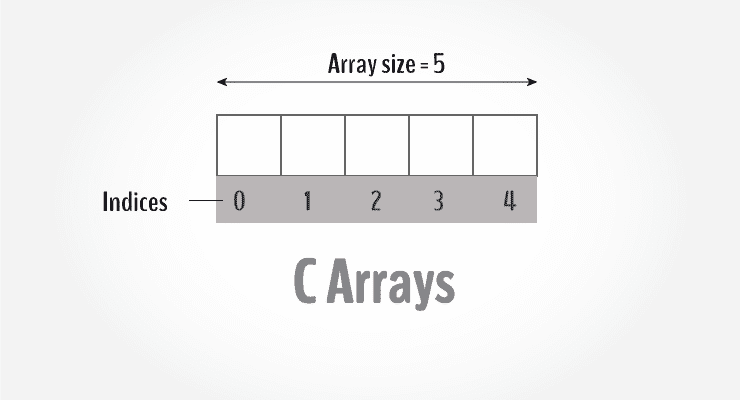在本教程中,您将学习如何使用数组。 您将借助示例学习如何声明,初始化和访问数组的元素。

数组是可以存储多个值的变量。 例如,如果要存储 100 个整数,则可以为其创建一个数组。
int data[100];
如何声明数组?
dataType arrayName[arraySize];
例如,
float mark[5];
在这里,我们声明了一个浮点类型的数组mark。 其大小为 5。意味着,它可以容纳 5 个浮点值。
重要的是要注意,数组的大小和类型一旦声明就无法更改。
访问数组元素
您可以按索引访问数组的元素。
假设您如上所述声明了数组mark。 第一个元素是mark [0],第二个元素是mark [1],依此类推。

少量要点:
- 数组的第一个索引为 0,而不是 1。在此示例中,
mark[0]是第一个元素。 - 如果数组的大小为
n,则要访问最后一个元素,将使用n-1索引。 在此示例中,mark[4] - 假设
mark[0]的起始地址为2120d。 然后,mark[1]的地址将是2124d。 同样,mark[2]的地址将是2128d,依此类推。
这是因为float的大小为 4 个字节。
如何初始化数组?
在声明期间可以初始化数组。 例如,
int mark[5] = {19, 10, 8, 17, 9};
您也可以像这样初始化一个数组。
int mark[] = {19, 10, 8, 17, 9};
在这里,我们没有指定大小。 但是,当我们使用 5 个元素进行初始化时,编译器知道其大小为 5。

这里,
mark[0] is equal to 19mark[1] is equal to 10mark[2] is equal to 8mark[3] is equal to 17mark[4] is equal to 9
更改数组元素的值
int mark[5] = {19, 10, 8, 17, 9}// make the value of the third element to -1mark[2] = -1;// make the value of the fifth element to 0mark[4] = 0;
输入和输出数组元素
这是如何从用户那里获取输入并将其存储在数组元素中的方法。
// take input and store it in the 3rd elementscanf("%d", &mark[2]);// take input and store it in the ith elementscanf("%d", &mark[i-1]);
这是打印数组单个元素的方法。
// print the first element of the arrayprintf("%d", mark[0]);// print the third element of the arrayprintf("%d", mark[2]);// print ith element of the arrayprintf("%d", mark[i-1]);
示例 1:数组输入/输出
// Program to take 5 values from the user and store them in an array// Print the elements stored in the array#include <stdio.h>int main() {int values[5];printf("Enter 5 integers: ");// taking input and storing it in an arrayfor(int i = 0; i < 5; ++i) {scanf("%d", &values[i]);}printf("Displaying integers: ");// printing elements of an arrayfor(int i = 0; i < 5; ++i) {printf("%d\n", values[i]);}return 0;}
输出
Enter 5 integers: 1-33403Displaying integers: 1-33403
在这里,我们使用for循环从用户那里获取 5 个输入并将它们存储在一个数组中。 然后,使用另一个for循环,这些元素显示在屏幕上。
示例 2:计算平均值
// Program to find the average of n numbers using arrays#include <stdio.h>int main(){int marks[10], i, n, sum = 0, average;printf("Enter number of elements: ");scanf("%d", &n);for(i=0; i<n; ++i){printf("Enter number%d: ",i+1);scanf("%d", &marks[i]);// adding integers entered by the user to the sum variablesum += marks[i];}average = sum/n;printf("Average = %d", average);return 0;}
输出
Enter n: 5Enter number1: 45Enter number2: 35Enter number3: 38Enter number4: 31Enter number5: 49Average = 39
在这里,我们计算了用户输入的n个数字的平均值。
访问元素超出范围!
假设您声明了一个由 10 个元素组成的数组。 比方说
int testArray[10];
您可以从testArray[0]到testArray[9]访问数组元素。
现在,假设您尝试访问testArray[12]。 该元素不可用。 这可能会导致意外输出(不确定的行为)。 有时您可能会遇到错误,而其他时候您的程序可能会正确运行。
因此,永远不要访问数组边界之外的元素。
多维数组
在本教程中,您了解了数组。 这些数组称为一维数组。
在下一个教程中,您将学习多维数组(数组的数组)。

